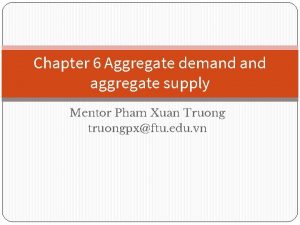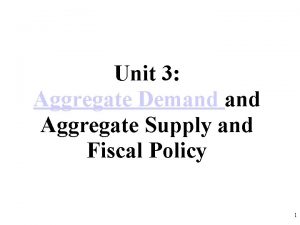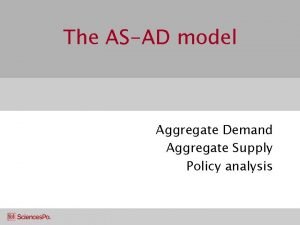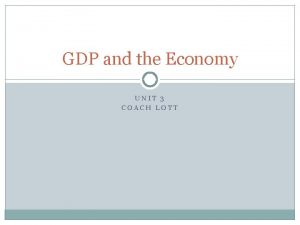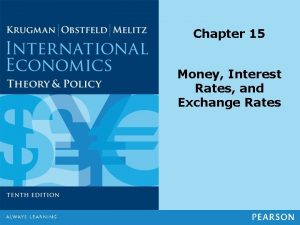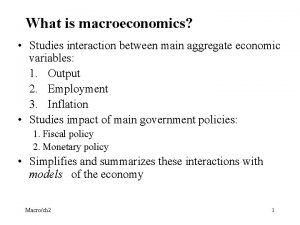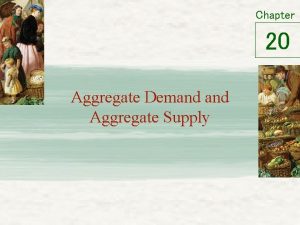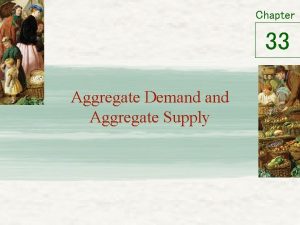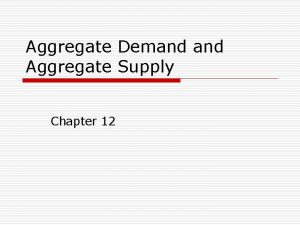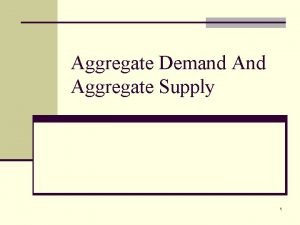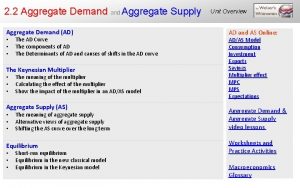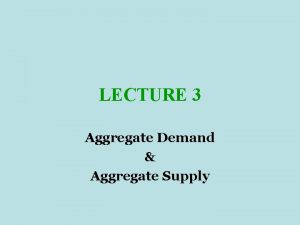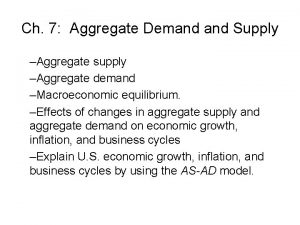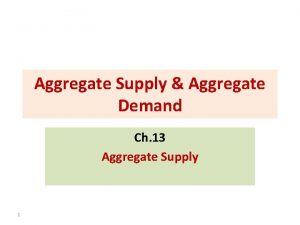Chapter 14 Practice Quiz Tutorial Aggregate Demand Supply




















- Slides: 20

Chapter 14 Practice Quiz Tutorial Aggregate Demand Supply © 2000 South-Western College Publishing 1

1. The aggregate demand curve is defined as a. the net national product. b. the sum of wages, rent, interest, and profits. c. the real GDP purchased at different possible price levels. d. the total dollar value of household expectations. C. Answers a, b, and c are not real GDP purchases at different possible price levels during a time period. 2

2. When the supply of credit is fixed, an increase in the price level stimulates the demand for credit, which, in turn, reduces consumption and investment spending. This argument is called the a. real balance effect. b. interest-rate effect. c. net exports effect. d. substitution effect. B. At a high price level, the demand for borrowed money increases and results in higher cost of borrowing (interest rates). High interest rates result in lower consumption and investment spending. 3

3. The real balance effect occurs because a higher price level will reduce the real value of people’s a. financial assets. b. wages. c. unpaid debt. d. physical investments. A. As price increase the dollars people receive in their paychecks and wealth are worth less. As a result, real GDP demand decreases. 4

4. The net exports effect is the inverse relationship between net exports and the _______of an economy. a. Real GDP. b. GDP deflator. c. Price level. d. Consumption spending. C. A higher domestic price level makes U. S. goods more expensive relative to foreign goods and vice versa. 5

5. Which of the following will shift the aggregate demand curve to the left? a. An increase in exports. b. An increase in investment. c. An increase in government spending. d. A decrease in government spending. D. Answers a, b, c shift the aggregate demand curve to the right. 6

6. Which of the following will not shift the aggregate demand curve to the left? a. Consumers become more optimistic about the future. b. Government spending decreases. c. Business optimism decreases. d. Consumers become pessimistic about the future. A. Answers b, c and d shift the aggregate demand curve leftward. 7

7. The popular theory prior to the Great Depression that the economy will automatically adjust to achieve full employment is a. supply-side economics. b. Keynesian economics. c. classical economics. d. mercantilism. C. Supply-side economic concerns shifts in aggregate supply. Keynesians do not believe the economy automatically adjusts to full employment. Mercantilism is the idea that gold or silver is the source of a nation’s wealth. 8

8. Classical economists believed that the a. price system was stable. b. goal of full employment was impossible. c. price system automatically adjusts the economy to full employment in the long run. d. government should attempt to restore full employment. C. This is a key assumption for the vertical shape of the classical aggregate supply curve. 9

9. Which of the following is not a range on the eclectic or general view of the aggregate supply curve? a. Classical range. b. Keynesian range. c. Intermediate range. d. Monetary range. D. Answers a, b, and c are three district ranges of the aggregate supply at a level of real GDP below full employment. 10

Three Ranges of the Aggregate Supply Curve Price Level AS Classical Range Intermediate Range Full Employment Keynesian Range Real GDP YK YF 11

10. Macroeconomic equilibrium occurs when a. aggregate supply exceeds aggregate demand. b. the economy is at full employment. c. aggregate demand equals aggregate supply. d. aggregate demand equals the average price level. C. Note that aggregate demand can equal aggregate supply at a level of real GDP below full employment. 12

11. Along the classical or vertical range of the aggregate supply curve, a decrease in the aggregate demand curve will decrease a. both the price level and real GDP. b. only real GDP. c. only the price level. d. neither real GDP or the price level. C. Along the vertical range of the aggregate supply curve, the economy is at full employment and only the price level changes. 13

12. Other factors held constant, a decrease in resource prices will shift the aggregate a. demand curve leftward. b. demand curve rightward. c. supply curve leftward. d. supply curve rightward. D. Changes in production costs do not affect the aggregate demand curve. 14

13. Assuming a fixed aggregate demand curve, a leftward shift in the aggregate supply curve causes a (an) a. increase in the price level and a decrease in real GDP. b. increase in the price level and an increase in real GDP. c. decrease in the price level and a decrease in real GDP. d. decrease in the price level and an increase in real GDP. A. 15

200 150 Price Level Cost Push Inflation AS 2 100 AS 1 E 2 Full employment E 1 50 AD Real GDP 2 4 6 8 10 12 14 16 17 16

14. An increase in the price level caused by a rightward shift of the aggregate demand curve is called a. cost-push inflation. b. supply shock inflation. c. demand shock inflation. d. demand-pull inflation. D. 17

200 150 Price Level Demand Pull Inflation 100 AS E 2 E 1 50 Real GDP Full employment AD 2 AD 1 2 4 6 8 10 12 14 16 17 18

15. Suppose workers become pessimistic about their future employment, which causes them to save more and spend less. If the economy is on the intermediate range of the aggregate supply curve, then a. both real GDP and the price level will fall. b. real GDP will fall and the price level will rise. c. real GDP will rise and the price level will fall. d. both real GDP and the price level will rise. A. A leftward movement of the aggregate demand curve along a downward sloping aggregate supply curve will result in lower 19 prices and less employment.

END 20
 Chapter 33 aggregate demand and aggregate supply
Chapter 33 aggregate demand and aggregate supply Aggregate demand and aggregate supply
Aggregate demand and aggregate supply Unit 3 aggregate demand and aggregate supply
Unit 3 aggregate demand and aggregate supply Unit 3 aggregate demand aggregate supply and fiscal policy
Unit 3 aggregate demand aggregate supply and fiscal policy Unit 3 aggregate demand aggregate supply and fiscal policy
Unit 3 aggregate demand aggregate supply and fiscal policy Ad as
Ad as Shift in sras curve
Shift in sras curve Aggregate supply and demand graph
Aggregate supply and demand graph Aggregate planners seek to match supply and demand
Aggregate planners seek to match supply and demand Module 5 supply and demand introduction and demand
Module 5 supply and demand introduction and demand Matching supply with demand
Matching supply with demand Cannot mix aggregate and non aggregate tableau
Cannot mix aggregate and non aggregate tableau Shifters of aggregate supply rap
Shifters of aggregate supply rap Supply side shock
Supply side shock Dad das model
Dad das model Aggregate demand curve
Aggregate demand curve Recessionary gap aggregate demand
Recessionary gap aggregate demand The aggregate real money demand schedule l(r,y)
The aggregate real money demand schedule l(r,y) The aggregate real money demand schedule l(r,y)
The aggregate real money demand schedule l(r,y) Contractionary monetary policy
Contractionary monetary policy Real gdp formula
Real gdp formula





